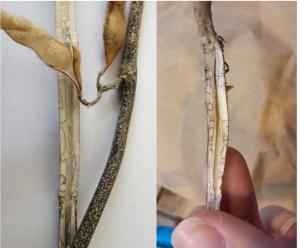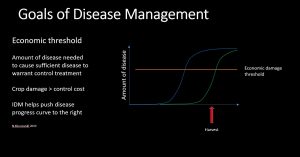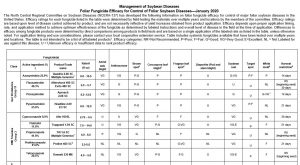The 2019 soybean harvest was problematic. Wet weather delayed harvest in many parts of the state, and a hard early frost added additional insult to injury (pun intended). Unfortunately, a wet finish to the field season can reduce seed quality by facilitating the development of several diseases of soybean seed. The main players are Phomopsis seed decay (caused predominantly by Diaporthe longicolla), Purple seed stain (caused by Cercospora kikuchii and C. flagellaris), and seed infection by the Frogeye leafspot pathogen (C. sojina). Infected seeds can be white and flaky or shriveled (Diaporthe), or pink to dark purple in color (Cercospora spp). If harvested wet and not stored properly, you might observe other molds and fungal saprophytes snacking on your seeds and a fetid odor reminiscent of a dirty locker room.
Quality issues can cause loads to be downgraded and producers may suffer dockage at the gate. Of more importance currently is the effect poor quality seed can have on stands. Infection of seed by the aforementioned pathogens can reduce germination as the fungi colonize the seed and degrade it’s components for subsistence. There are a few things you can do reduce risk for reduced germination and poor stands from poor quality seed in 2020.
1) Clean your seed– this will remove lightweight, cracked, and otherwise trashy seed that is unlikely to germinate. The less bad seed is better, but less than 10% is optimal.
2) Before planting, test your seed for germination. How you handle and store your seed over winter may also negatively affect germination, in addition to seed infecting fungi.
3) If you have more than 10% of your seed infected with the aforementioned pathogens, consider a seed treatment specifically labeled for these fungi. click here for the 2020 seed treatment efficacy table to help you choose products that contain the most efficacious active ingredients. Fungicides will not revive dead seeds. However, they can reduce additional reductions in germination associated with fungal infections. Some studies indicate that you can reduce additional germination reductions by up to 15% in certain situations.
4) Adjust your populations to account for poor quality seed and reduced germination
5) Plant at the appropriate depth and into warm soils. The faster your seeds pop out of the ground the fewer issues you will have. The longer the seeds set below the soil surface, the more opportunities potential pathogens have to feed on those seeds and prevent germination.
Of course, when it comes to harvesting, you never can control the weather. In seed production fields, fungicide applications between R3-R5 may help reduce seed infection, but keep in mind harvest restrictions and use of seed (feed/food vs seed). As an example, here is a trial I conducted in 2016 looking at foliar fungicide impacts on foliar and seed diseases in soybeans. Kleczewskisoybeanfoliar2016PDMR_TF
Data from Iowa state indicate that in some instances, fungicides can increase incidence of Diaporthe in certain situations. Timely harvest, and appropriate handling and storage are essential.
Keep these tips in mind as you prepare to get your soybeans planted this season.
Stay safe!
Dr. K.



